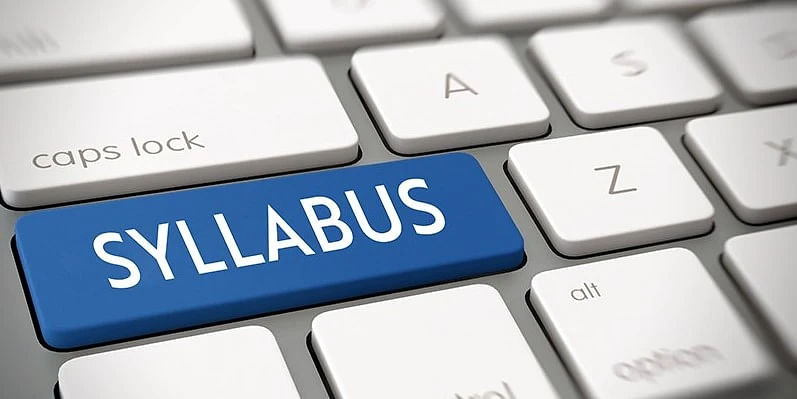
Table of Contents
SSC CGL Tier 2 Syllabus 2024 is an essential part of the examinations for applicants. Candidates must study the subject matter and exam pattern to adequately prepare for the upcoming exams. A comprehensive overview of the SSC CGL Syllabus has been discussed in the sections below.
SSC syllabus for CGL posts was declared on the official website by Staff Selection Committee. Students must know about SSC CGL Syllabus to prepare a methodical system for studying the subjects. This will help them to score a high ranking and marks in the SSC CGL 2024 Exam. It is important to know about SSC CGL eligibility criteria because all students must be satisfied to attempt this exam.
| SSC CGL Exam Date 2024 | SSC CGL Admit Card 2024 |
SSC CGL 2024 Exam Pattern
The SSC CGL 2024 Exam is conducted in 4 tiers:
| Tier 1 | Computer Based Test |
| Tier 2 | Computer Based Test |
| Tier 3 | Pen and Paper (Descriptive) |
| Tier 4 | Computer Proficiency + Skill Test (Wherever Required) + Document Verification |
A comprehensive breakdown of the SSC CGL 2024 exam has been provided below tier-wise:
SSC CGL Tier 2 Exam Pattern 2024
| Tier II | Subject | No. Of Questions | Maximum Marks | Time Allowed |
| Paper I: Quantitative Abilities | 100 | 200 | 120 minutes (for each paper) | |
| Paper II: English Comprehension and Language | 200 | 200 | ||
| Paper III: Statistics | 100 | 200 | ||
| Paper IV: General Studies (Finance and Economics) | 100 | 200 |
Note: A negative marking scheme of 1 mark penalty is exercised for Paper I and Paper II. For Paper III and Paper IV, conducting authorizes exercise a penalty of 0.50 marks against each incorrect answer.
SSC CGL Tier 3 Exam Pattern 2024
| Tier III | Subject | Maximum Marks | Time Allowed |
| Descriptive Paper in English or Hindi (Essay-writing/Precis/Letter Writing/Application Writing) | 100 | 60 minutes (total) |
SSC CGL Tier 1 Exam Pattern 2024
| Tier I | Subject | No. Of Questions | Maximum Marks | Time Allowed |
| General Intelligence and Reasoning | 25 | 50 | 60 minutes (total) | |
| General Awareness | 25 | 50 | ||
| Quantitative Aptitude | 25 | 50 | ||
| English Comprehension | 25 | 50 |
Note: A negative marking of 0.50 marks is initiated for every wrong response in the Tier 1 exam.
SSC CGL Syllabus 2024
Based on each tier level of the exam, the SSC CGL Syllabus has been classified. It will be useful for the students to visit the SSC CGL Exam Pattern page and read it to get a clear picture of this exam.
SSC CGL Tier-2 Syllabus 2024
The Tier-2 syllabus of the SSC CGL Syllabus 2024 is given below.
(A) Paper-I: Quantitative Ability
- The questions will be designed to test the ability to use numbers appropriately. Any aspiring candidate must be good in his mathematical and computational skills to ace this section.
- The scope of the test will be the computation of whole numbers, decimals, fractions, and relationships between numbers.
- Percentage, Ratio & Proportion, Square roots, Averages.
- Interest, Profit and Loss, Discount, Partnership Business.
- Mixture and Allegation.
- Time, Time & Work.
- Basic algebraic identities of School Algebra and elementary surds.
- Graphs of Linear Equations.
- Triangle and its various kinds of centres, Congruence, and similarity of triangles.
- Circle and its chords, tangents, angles subtended by chords of a circle, common tangents to two or more circles, Triangle, Quadrilaterals, Regular Polygons, Circle, Right Prism, Right Circular Cone, Right Circular Cylinder, Sphere, Hemispheres.
- Rectangular Parallelepiped, Regular Right Pyramid with a triangular or square base.
- Trigonometric ratio, Degree and Radian Measures, Standard Identities, Complementary angles, Heights and Distances.
- Histogram, Frequency polygon, Bar diagram & Pie chart.
(B) Paper-II: English Language & Comprehension
- Questions in this section will be designed to test the candidate’s understanding and knowledge of the English Language.
- Will be based on the spot the error, fill in the blanks, synonyms, antonyms, spelling/detecting misspelt words, idioms & phrases, one-word substitution, improvement of sentences, active/passive voice of verbs, conversion into the direct/indirect narration, shuffling of sentence parts, shuffling of sentences in a passage, cloze passage & comprehension passage.
(C) Paper-III: Statistics
- This paper involves Statistics for Junior Statistical Officer (JSO), Ministry of Statistics & Programme Implementation.
- Collection Classification and Presentation of Statistical Data – Primary and secondary data, Methods of data collection, Tabulation of data, Graphs and charts, Frequency distributions, Diagrammatic presentation of frequency distributions.
- Measures of Central Tendency- Common measures of central tendency – mean, median and mode, Partition values - quartiles, deciles, percentiles.
- Measures of Dispersion- Common measures of dispersion – range, quartile deviations, mean deviation and standard deviation, Measures of relative dispersion.
- Moments, Skewness and Kurtosis – Different types of moments and their relationship, the meaning of skewness and kurtosis, and different measures of skewness and kurtosis.
- Correlation and Regression – Scatter diagram, simple correlation coefficient, simple regression lines, Spearman’s rank correlation, Measures of association of attributes, Multiple regression, Multiple and partial correlations (For three variables only).
- Probability Theory – Meaning of probability, Different definitions of probability, Conditional probability, Compound probability, Independent events, Bayes theorem.
- Random Variable and Probability Distributions – Random variable, Probability functions, Expectation and Variance of a random variable, Higher moments of a random variable, Binomial, Poisson, Normal and Exponential distributions, Joint distribution of two random variables (discrete).
- Sampling Theory – Concept of population and sample, Parameter and statistic, Sampling and non-sampling errors, Probability and non-probability sampling techniques (simple random sampling, stratified sampling, multistage sampling, multiphase sampling, cluster sampling, systematic sampling, purposive sampling, convenience sampling and quota sampling), Sampling distribution (statement only), Sample size decisions.
- Statistical Inference - Point estimation and interval estimation, properties of a good estimator, Methods of estimation (Moments method, Maximum likelihood method, Least squares method), Testing of hypothesis, Basic concept of testing, Small sample and large sample tests, Tests on Z, t, Chi-square and F statistic, Confidence intervals.
- Analysis of Variance - Analysis of one-way classified data and two-way classified data.
- Time Series Analysis - section of time series, Determinations of trend component by different methods, Measurement of seasonal variation by different methods.
- Index Numbers - Meaning of Index Numbers, Problems in the construction of index numbers, Types of index numbers, Different formulae, Base shifting and splicing of index numbers, Cost of living Index Numbers, Uses of Index Numbers.
(D) Paper IV: General Studies (Finance and Economics)
Part A: Finance and Accounts (80 marks)
- Fundamental principles and the basic concept of Accounting.
- Financial Accounting: Nature and scope, Limitations of Financial Accounting, Basic Concepts and Conventions, Generally Accepted Accounting Principles.
- Basic concepts of accounting: Single and double entry, Books of Original Entry, Bank Reconciliation, Journal, Ledgers, Trial Balance, Rectification of Errors, Manufacturing, Trading, Profit & Loss Appropriation Accounts, Balance Sheet, Distinction between Capital and Revenue Expenditure, Depreciation Accounting, Valuation of Inventories, Non-profit organisations Accounts, Receipts and Payments and Income & Expenditure Accounts, Bills of Exchange, Self Balancing Ledgers.
Part B: Economics and Governance (120 marks)
- Comptroller & Auditor General of India: CAG Constitutional provisions, Roles, and responsibility.
- Finance Commission: Finance Commission's Role and functions.
- Basic Concept of Economics: Introduction to Micro Economics, definition, scope, and nature of Economics, Methods of economic study and Central problems of an economy and Production possibilities curve.
- Theory of Demand and Supply: Meaning and determinants of demand, Law of demand and Elasticity of demand, Price, income and cross elasticity, Theory of consumer’s behaviour approach and Indifference curve approach, Meaning and determinants of supply, Law of supply and Elasticity of Supply.
- Theory of Production and Cost: Meaning and Factors of production, Laws of production - Law of variable proportions and Laws of returns to scale.
- Forms of Market and Price Determination: Various forms of markets - Perfect Competition, Monopoly, Monopolistic Competition and Oligopoly and Price Determination in these markets.
- Indian Economy: Nature of the Indian Economy, Role of different sectors - Role of Agriculture, Industry, and Services - their problems and growth. National Income of India - Concepts of national income, Different methods of measuring national income. Population - Its size, rate of growth and its implication on economic growth. Poverty and unemployment - Absolute and relative poverty, types, causes and the incidence of unemployment. Infrastructure - Energy, Transportation, Communication.
- Economic Reforms in India: Economic reforms since 1991, Liberalisation, Privatisation, Globalisation, and Disinvestment.
- Money and Banking: Monetary/Fiscal policy - Role and functions of Reserve Bank of India, functions of commercial Banks/RRB/Payment Banks. Budget and Fiscal Deficits and Balance of Payments, Fiscal Responsibility and Budget Management Act, 2003
- Role of Information Technology in Governance.
SSC CGL Syllabus 2024 for Tier-1
Following are the topics and sub-topics in each section of the SSC CGL syllabus: Tier-1.
(A) General Intelligence & Reasoning
SSC CGL Syllabus 2024 would include questions of both verbal and non-verbal types. Practising questions on different varieties would help the candidates to ace this section. The following topics are included in this section.
- Analogy: Semantic Analogy, Symbolic/Number Analogy, Figural Analogy.
- Classification: Semantic Classification, Symbolic/Number Classification, Figural Classification.
- Series: Semantic Series, Number Series, Figural Series.
- Reasoning: Problem Solving, Word Building, Analysis, Relationship concepts, syllogistic reasoning.
- Observation: Judgment, decision making, visual memory, discrimination, observation.
- Operations: Numerical Operations, symbolic Operations.
- Visualisations: Trends, Space Orientation, Space Visualization, Venn Diagrams, Drawing inferences.
- Patterns: Punched hole/pattern – folding & un-folding, Figural Pattern – folding and completion.
- Matching: Indexing, Address matching, Date & city matching.
- Coding & de-coding: Classification of centre codes/roll numbers, Small and capital letters/numbers coding, decoding and classification, Embedded Figures.
- Intelligence: Critical thinking, Emotional Intelligence, Social Intelligence, Statement conclusion.
- Other sub-topics, if any.
(B) General Awareness
Questions in this component will be aimed at testing the candidate's general awareness of the environment around them and its application to society. Questions will also be designed to test knowledge of current events and such matters of everyday observations and experience in their scientific aspect as may be expected of any educated person.
The test will also include questions relating to India and its neighbouring countries, especially about History, Culture, Geography, Economic Scene, General Policy and Scientific Research.
(C) English Comprehension
The candidate’s ability to understand correct English, basic comprehension, writing ability, etc. would be tested. An avid reader would be able to clear this section easily.
SSC CGL Syllabus 2024 Direct Download
Candidates may download the official SSC CGL 2024 Syllabus from the following link presented below:
| Direct Link to Download SSC CGL 2024 Syllabus | Download |
How to Download the SSC CGL Syllabus 2024?
To access the official SSC CGL Syllabus 2024, applicants are advised to observe the following process:
- Step 1. Applicants have to visit the official SSC website at ssc.nic.in
- Step 2. Click on the "Candidate's Corner" link on the official landing homepage.
- Step 3. Click on the "Syllabus" link.
- Step 4. A new page will appear. Click on "CGL Syllabus" on that page.
- Step 5. A new window with the SSC CGL Syllabus will appear for all Tier exams. Interested applicants can print out the PDF file to review at any point in the future.
Preparation Tips for SSC CGL 2024 Exam
Applicants must realize the importance of dedicatedly studying the SSC CGL Syllabus 2024 for examinations. A few suggestions listed below will not only enhance the preparation strategies students devise, but also institute a sense of candidates and preparedness to go through the selection process:
- First and foremost, applicants must keep a healthy check on their mental and physical status to optimise their study efforts. Any candidate not feeling their best mentally will encounter hurdles while studying the syllabus.
- Secondly, potential candidates must conduct a gap analysis by studying the SSC CGL Syllabus for 2024 and comparing their current knowledge to that.
- The prior point leads to the important step of creating a meticulously thought-out timetable to allocate available resources effectively, just as time, reference books, etc.
- For an optimum study session, candidates must realize the importance of taking help from resources such as reference books, journals, newspapers, online video tutorials, etc.
- A sure shot way of attempting the exam in a timely and stress-free manner is by solving the previous year's question papers and sample tests.
- Candidates must be mindful of any current affairs or new developments in their field through newspapers, magazines and journals..
- Using NLP techniques such as mnemonic devices and similar techniques helps to reinforce the concepts by revising them with the help of an easy system.
FAQs on SSC CGL Syllabus
Q: Is there any negative marking for the SSC CGL 2024 recruitment?
Q: What is the SSC CGL Syllabus 2024 for the Tier 3 exam?
Q: What is the SSC CGL 2024 Syllabus for Tier 1 Exam?
Q: What are the resources to use for SSC CGL Exam 2024?
Q: How can we download the SSC CGL Syllabus for 2024 exam?

























